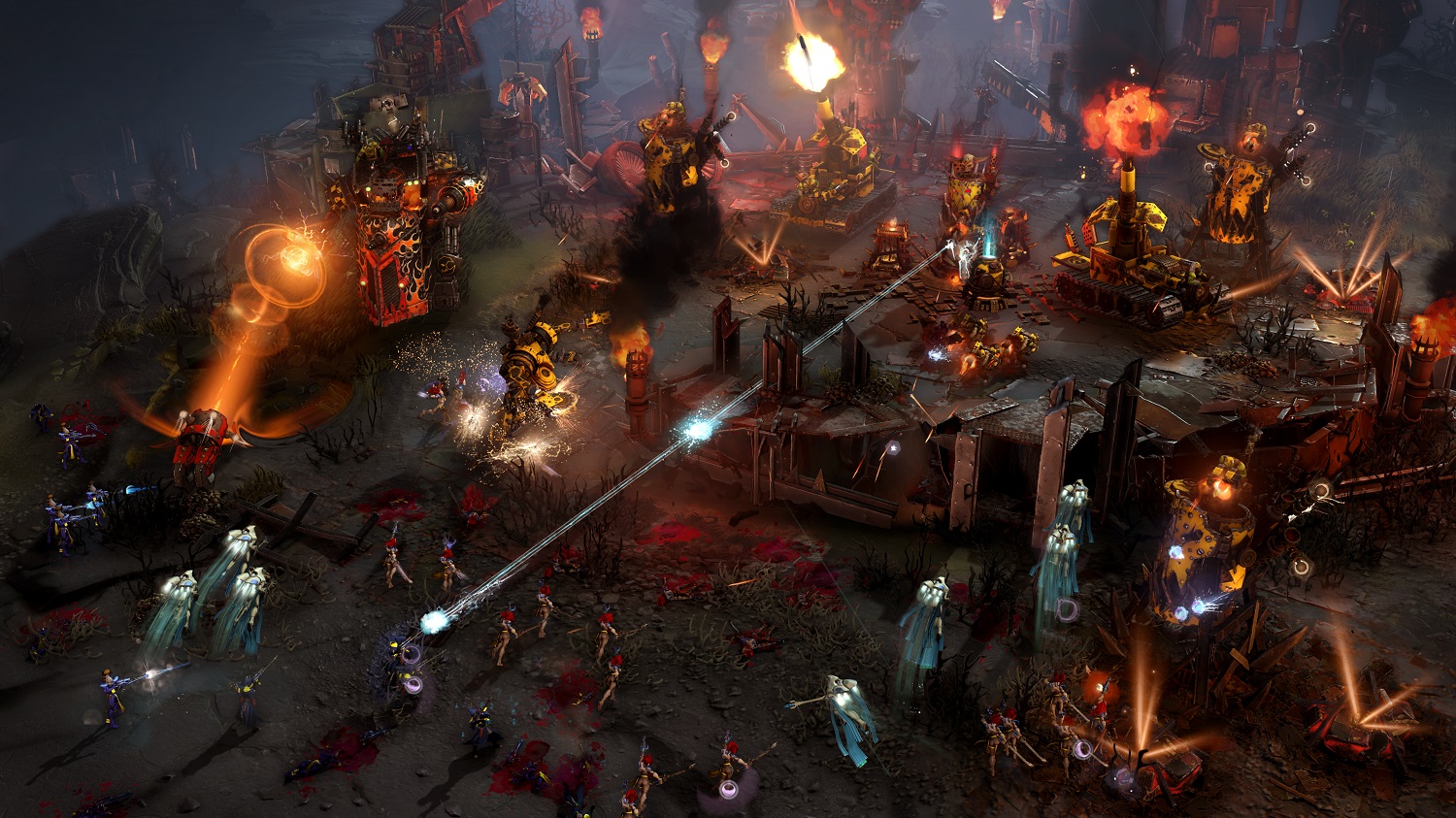Warhammer 40K Dawn of War 3 review: A fun and competent RTS but not the sequel this series deserves
Relic Entertainment once again brings the tabletop carnage to the digital realm.
Warhammer 40K: Dawn of War 3
Platforms: PC
Developer: Relic Entertainment
Publisher: Sega
Release Date: Out Now
Where To Buy
Amazon /Steam / Green Man Gaming / ShopTo
At the merest mention of the Dawn of War franchise, you know what to expect. Dawn of War 3 meets those expectations perfectly, but rarely exceeds them.
It's a real-time strategy game, and it does an impressive job of translating the tabletop beat-downs of the Warhammer 40k universe to a digital format. Bodies crumple under gunfire, and explosions scatter fighters in the wind, every single one of them exquisitely detailed.
Battles crackle and pop, with the base building and vast armies that were so emblematic of Dawn of War ensuring plenty of meat for the grinder. Meanwhile, the spectacularly powerful hero units of Dawn of War 2 return in a new form, as more MOBA-esque Elites, with abilities that can be activated to allow them to become godless killing machines, tearing through enemies as if they're nothing.
The combatants in this particular space war are stereotypes, sure, but it's hard to feel too aggrieved when Warhammer 40k near singlehandedly invented the sci-fi archetypes we now take for granted. Seven-foot tall space-fascists clomp around in heavy power armour – big men with big guns firing big bullets. Then there are the Orks, hulking green giants uttering inane thoughts in a thick cockney accent. And just when you think that everyone in this game is muscled enough to generate their own gravity, along come the Eldar, who dance around the battlefield and call upon powerful magic. You would be forgiven for calling them space-elves.
Unfortunately, though, it's not only the combatants that are stereotypical. Dawn of War 3's single player campaign feels like a tutorial in 17 parts, with each of the missions seemingly designed to teach you how to compete effectively in multiplayer. Fans of Dawn of War might appreciate the return of protagonist Gabriel Angelos, but the campaign is by-the-numbers, and barely a level went by that didn't overstay its welcome.
It's during the campaign that I learnt a healthy degree of hatred for Dawn of War 3's user interface too. In a real-time strategy game, you need to be able to ascertain quickly how many resources you have and what's going on, and the game doesn't present any of that information particularly well. This problem fades with time as you grow accustomed to the layout, but I struggled before then to work out if I had enough of a given resource to build something and how to select my troops. When I was trying to bring out quickly a few more squads of units, or desperately call in reinforcements, it was an unwelcome distraction.


The campaign largely seems to exist to teach you the differences between the three armies, and if you don't have experience with the Warhammer universe, you might appreciate the heads-up.
Each of the three armies has their own thing going on, each with their own sense of tempo. The Eldar are agile and use their mobility for hit-and-run tactics, jumping unaware patrols or baiting enemies in to attack a weaker force before surprising them by warping reinforcements in via a Webway. The Space Marines are slow to rumble to action, but can drop their units from space directly onto the battlefield to reinforce units. They're better at late-game engagements, where they can bring armoured vehicles to wreck enemy defences.
Finally, there are the Orks, running on WAAAAAAAGH power. They are at their strongest when they declare one of these WAAAAAAAGH!!!'s, an onslaught that sees their number flowing over the battlefield like water as opponents try to weather the storm desperately. Orks also upgrade themselves using scrap gathered from wreckage and debris strewn across the battlefield.
Once you've learnt the differences, you can abandon the lacklustre campaign and dive into the multiplayer. It comes in 1 vs 1, 2 vs 2 and 3 vs 3 flavours and you can play against human or AI opponents. Playing in the multiplayer will also let you choose which army you would like to play as from the tabletop, and they all have their own paint jobs. For me, I like the Space Marine Hawklords, clad in a lovely purple hue. If you can't find anything that suits then a quick visit to the Army Painter will let you spruce up your units with a variety of colours.
There are only eight multiplayer maps at the moment, but they're tactically interesting, with shortcuts and alternate routes available for units taking advantage of grappling hooks, teleports or jetpacks. Here you can also see the MOBA elements working their way into the design, with multiplayer matches designed not for you to decimate your enemies — although this will often happen —but instead for you to take out their outer shield generators, then their inner turrets and finally their power core.

The way the resources work and the focus on keeping units healed and reinforced in the field means that as you grow your army, you'll spend an increasing amount of time concentrating on the macro level and not micromanaging every aspect. On the flip side, those with smaller armies who've just taken a kicking can exploit this, using their Elites in a smart way or making the most of their resources to claw back an advantage. A game of Dawn of War 3 has very rarely felt over before it was over, even when you're pouring fire into a towering unit and praying for it to die. The two halves of the game often feel like they're grinding into each other, causing a little confusion in several systems.
Combat isn't particularly quick, but it is lethal, and once your soldiers get mired in melee combat against a superior enemy, it's unlikely you'll be able to save them. Everything feels almost pleasingly clunky in the combat, and there's something about trying to pull your damaged units out of the melee before they get swallowed up in the carnage that I enjoyed.
Multiplayer is where the game shines, letting you select a trio of Elites to take into battle, who earn experience and unlock new abilities for you to choose. These Elite Doctrines straddle the line between making your elite units more powerful or bestowing useful abilities on your entire army. There's some depth here, but in play, it's often lost in the roar of battle.
Ultimately Dawn of War 3 feels like a fairly generic, if thoroughly competent real-time strategy game. The genre is going through a period of rapid reiteration, and perhaps the most surprising thing about Dawn of War 3 is how unsurprising it is. Its predecessor was a bold reimagining that took both the series and the genre to unexpected places, but with this, it feels like the franchise is playing defensively, sticking to what it knows. I don't think Dawn of War 3 is the game the franchise deserves. Its flaws are legion, but I can't begrudge the game when it's so much fun to play. The single player is shallow nonsense, but the game pulls it back in multiplayer, and Warhammer fans will struggle not to smile when everything whirrs into explosive motion.
For all the latest video game news follow us on Twitter @IBTGamesUK.
© Copyright IBTimes 2025. All rights reserved.




















